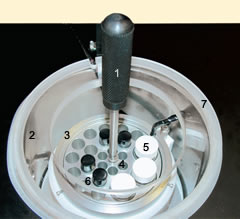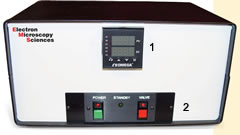Freeze Substitution Module
Discontinued and no longer available
Out of stock
Product Information
In the 1980s descriptive ultrastructure analysis essentially came to the end and microscopists found they needed to correlate structure with function to advance their research. About the same time biochemists and molecular biologists were able to see where molecules interacted with cellular membranes. It was essential to marry the work of the structural biologists to the functional biologists by preserving the ultrastructure in the antigenicity of the tissue. During this research it was determined early on that conventional methods of fixation using chemicals were unsuitable for such studies because of the extensive redistribution of proteins, extraction of cytoplasmic constituents, and destruction of cellular antigenicity.
Freeze substitution, which is the dissolution of freezing water (ice) in the frozen specimen at low temperature has turned out to be one of the most powerful techniques in electron microscopy. The dissolution of the ice within the specimen is achieved by substituting water molecules with molecules of an inorganic solvent like acetone, while simultaneously fixing the biological material with Osmium tetroxide and blocks staining with Uranyl acetate. This slow dissolution of the ice takes place over many hours at slowly increasing temperatures. Once the substitution process is complete the samples can be infiltrated and embedded with a wide range of Epoxies or Acrylics. It is even possible to perform a low temperature embedding at -50° Celsius using specialized resins. The end results are beautifully preserved specimens possessing both antigenicity for your immuno-localization studies and perfect structural relationship for descriptive ultrastructure analysis.


